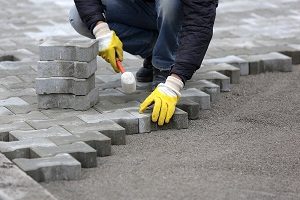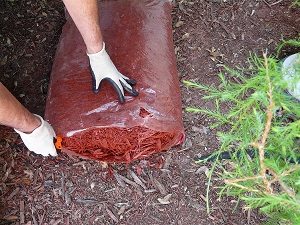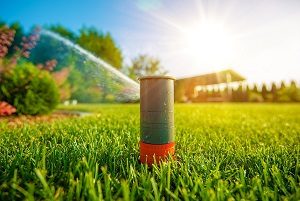 The great thing and horrible thing about grass is that it grows. You might find yourself grumbling as you have to start up the lawnmower, but it also means you’ll get fresh, green grass year after year. However, season after season your grass can gain a heavy buildup of dead grass (known as thatch), or the soil can be stomped flat by use. This compact thatch and soil can block air, water, and nutrients, causing your grass to starve. Today we’ll look at aerating basics and the right time for lawn aeration. Continue reading The Perfect Time for Lawn Aeration
The great thing and horrible thing about grass is that it grows. You might find yourself grumbling as you have to start up the lawnmower, but it also means you’ll get fresh, green grass year after year. However, season after season your grass can gain a heavy buildup of dead grass (known as thatch), or the soil can be stomped flat by use. This compact thatch and soil can block air, water, and nutrients, causing your grass to starve. Today we’ll look at aerating basics and the right time for lawn aeration. Continue reading The Perfect Time for Lawn Aeration
The Perfect Time for Lawn Aeration
 The great thing and horrible thing about grass is that it grows. You might find yourself grumbling as you have to start up the lawnmower, but it also means you’ll get fresh, green grass year after year. However, season after season your grass can gain a heavy buildup of dead grass (known as thatch), or the soil can be stomped flat by use. This compact thatch and soil can block air, water, and nutrients, causing your grass to starve. Today we’ll look at aerating basics and the right time for lawn aeration. Continue reading The Perfect Time for Lawn Aeration
The great thing and horrible thing about grass is that it grows. You might find yourself grumbling as you have to start up the lawnmower, but it also means you’ll get fresh, green grass year after year. However, season after season your grass can gain a heavy buildup of dead grass (known as thatch), or the soil can be stomped flat by use. This compact thatch and soil can block air, water, and nutrients, causing your grass to starve. Today we’ll look at aerating basics and the right time for lawn aeration. Continue reading The Perfect Time for Lawn Aeration
 Lawns are a living thing. With the proper lawn care, the
Lawns are a living thing. With the proper lawn care, the  Rain falls, flows, and pools. On an open lawn or garden, this isn’t an issue, but it can quickly lead to flooding and water damage problems on non-permeable surfaces. Your driveway is probably the second largest non-permeable surface – a surface which water cannot pass through, second only to your home’s roof. And while your roof is designed to channel water away from your home, your driveway may not be. In this blog, we’re going to troubleshoot your flooding problem, as well as provide the solution we’ve installed for many of our customers.
Rain falls, flows, and pools. On an open lawn or garden, this isn’t an issue, but it can quickly lead to flooding and water damage problems on non-permeable surfaces. Your driveway is probably the second largest non-permeable surface – a surface which water cannot pass through, second only to your home’s roof. And while your roof is designed to channel water away from your home, your driveway may not be. In this blog, we’re going to troubleshoot your flooding problem, as well as provide the solution we’ve installed for many of our customers.  Mulch is a groundcover product made from tree bark and wood chips that is common both in residential homes and commercial centers. No one can deny that a mulch covering on a garden or planting display can provide great aesthetics to your landscape, but this is only one of the perks. Mulch isn’t just designed to improve the look of your landscaping, but to promote the health of your plants in several ways. Let’s look at three other ways mulch makes everything better.
Mulch is a groundcover product made from tree bark and wood chips that is common both in residential homes and commercial centers. No one can deny that a mulch covering on a garden or planting display can provide great aesthetics to your landscape, but this is only one of the perks. Mulch isn’t just designed to improve the look of your landscaping, but to promote the health of your plants in several ways. Let’s look at three other ways mulch makes everything better.  There are many options to choose from when it comes to irrigation for your home or business, and it is a vital part of maintaining great lawns and plantings. From soaker hose and drip irrigation lines to keep gardens and other plants watered in the most efficient way, to sprinkler/spray systems, all the way to industrial-strength rotor systems for large estates or commercial lawns. Today we’ll look at the most commonly installed system: the lawn sprinkler system, and see how they work and why they are a good fit for most irrigation needs.
There are many options to choose from when it comes to irrigation for your home or business, and it is a vital part of maintaining great lawns and plantings. From soaker hose and drip irrigation lines to keep gardens and other plants watered in the most efficient way, to sprinkler/spray systems, all the way to industrial-strength rotor systems for large estates or commercial lawns. Today we’ll look at the most commonly installed system: the lawn sprinkler system, and see how they work and why they are a good fit for most irrigation needs.  Your lawn is a living thing, and like all living things, it feeds. Your grass consumes nutrients from the soil for growth, coloration, and root strength. However, these nutrients are both finite and water soluble. As your lawn continues to grow throughout the seasons, it will gradually degrade in quality. Colors will fade, brown spots will form from poor root structure, and it will be harder to maintain. This is the key of seasonal lawn fertilization: to reintroduce these nutrients to the soil so your lawn can thrive.
Your lawn is a living thing, and like all living things, it feeds. Your grass consumes nutrients from the soil for growth, coloration, and root strength. However, these nutrients are both finite and water soluble. As your lawn continues to grow throughout the seasons, it will gradually degrade in quality. Colors will fade, brown spots will form from poor root structure, and it will be harder to maintain. This is the key of seasonal lawn fertilization: to reintroduce these nutrients to the soil so your lawn can thrive.  You have a problem: you want to makeover your landscape, but something is blocking progress: the thick and deep root structure of shrubs and trees. While blackberry and ivy can be a pain to remove and kept removed, few things rival the sheer tenacity of shrubs and tree stumps. In this blog, we’ll look at the three steps to this step to a landscaping tear out problem.
You have a problem: you want to makeover your landscape, but something is blocking progress: the thick and deep root structure of shrubs and trees. While blackberry and ivy can be a pain to remove and kept removed, few things rival the sheer tenacity of shrubs and tree stumps. In this blog, we’ll look at the three steps to this step to a landscaping tear out problem.